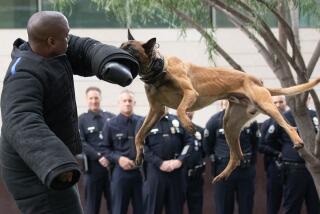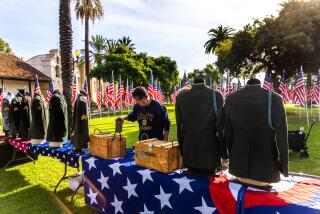Best Friends Even in Battle
- Share via
Not all bonds forged and sacrifices made during war were commemorated in a public way this Memorial Day weekend.
Author and Vietnam veteran John C. Burnam was at the Mall in Washington, D.C., for the dedication of the World War II Memorial, but his life’s passion evolved from his wartime work with Clipper. And Larry Chilcoat, another Vietnam vet, will hardly forget his constant military colleague, Geisha, whose picture he has carried in his wallet for the last 34 years.
Since World War I -- and continuing in conflicts today -- soldiers have patrolled, guarded and faced danger with trained military working dogs. The animals are fervently and affectionately remembered by their wartime handlers for their work ethic, companionship and extraordinary ability to smell and hear an approaching enemy yards before a human soldier could.
“These were just fabulous soldiers,” said Chilcoat, a former Air Force sergeant whose job was to patrol all night at Cam Ranh Bay Air Base in Vietnam from March 1969 to March 1970. It was lonely, scary duty and Geisha, a German shepherd, was both protector and companion.
“She’s the one that kept me awake, kept me inspired,” said Chilcoat, 56, who lives in Rockport, Texas, and is a member of the Vietnam Dog Handlers Assn. “We spent a lot of time in one-sided conversation.”
Chilcoat would patrol the perimeter of the base, watching Geisha for her “alert” -- freezing in mid-stride, right paw usually in front of her left, her body stiffened or her ears up, staring in one direction.
“Your dog is your security,” said Burnam, 57, who patrolled with two different dogs, Timber and Clipper, as part of the Army’s 44th Scout Dog Platoon, and later wrote the book “Dog Tags of Courage.”
After Timber was injured -- “He was never the same” -- Burnam worked with Clipper: “Our job was to lead combat patrols into enemy territory as the tip of the spear.... If we were crossing a clearing of short grass, if he stops and stands rigid, his ears pop up and the hair on his neck would raise up.”
Burnam said Clipper could hear the metallic click of a gun chamber long before he and his fellow soldiers could.
Monuments to these dogs, mostly German shepherds and Belgian Malinois -- prized for their intelligence and stamina -- dot military bases and pet cemeteries across the country. One of the best-known sits in a courtyard at the March Field Air Museum, adjacent to the March Air Reserve Base in Riverside.
Books, documentaries and websites chronicle stories of dogs and their handlers. Posted along with the online essays are numerous photos of young soldiers, in fields and camps, sometimes squatting next to a dog, an arm slung around the stalwart animal’s back in a comradely hug.
That stance of the soldier next to his alert dog may be immortalized in a proposed national monument to war dogs -- “to recognize the service and sacrifice of dogs for over 90 years,” said Burnam, who lives in Virginia and is one of a group of veterans lobbying Congress for such a monument. “Many of them died saving combatants and equipment.... It’s time they get a national memorial.”
Dogs have served as sentries, scouts, messengers and detectors of bombs and mines. Today, all military dogs are trained at Lackland Air Force Base in Texas and dispatched worldwide, including to Iraq.
A reported 4,000 dogs served in Vietnam, but few returned to the United States. (Chilcoat says his dog died of illness in Vietnam.) Some were given to the South Vietnamese army. Many were euthanized, as military dogs were considered unadoptable. However, retired military dogs now are allowed to be adopted.
The monument in the courtyard of the March Field Air Museum was dedicated in 2000 and is the site of a commemorative ceremony held annually in February. And in San Pedro at Ft. MacArthur, tucked into a corner of the grounds, is a dog cemetery that includes the remains of military dogs that stood watch over the Nike missile sites in the Los Angeles area.
During the 2000 dedication at the March Field Air Museum, Fred Lincoln, an 82-year-old Air Force veteran and museum volunteer, met Chilcoat and heard the story of his dog.
Moved by the account and saddened that so many Vietnam service dogs were euthanized, the Riverside man paid to have tiles placed around the memorial in remembrance of the canine soldiers.
One tile bears the names of Larry Chilcoat and Geisha, along with Geisha’s serial number.
“I just felt the dogs deserved a better fate,” Lincoln said.







